Contents
- What is Job Catfishing? (+Why It’s on The Rise)
- Why AI Isn't the Problem - You Are (If You Misuse It)
- How Skill Testing Is the Ultimate Job Catfish Filter
- 5 Rules for AI Use That Build Trust (Not Fake Personas)
- Building an Authentic Personal Brand With AI
Are you building a real online brand – or an AI-polished version of yourself that’s smarter, better looking, and more skilled than you really are? AI is a power companion, but it’s also fueling AI-dealization and authenticity drift. And now a sneaky new career trap has emerged: job catfishing. Here’s how top candidates walk the razors edge between performer and pretender – and how you can make sure you’re not part of this ‘bait and switch’ culture.
“Oh, thank god you look like yourself.”
This is what a head-hunter said to me a few short years ago, pre-AI boom.
He was so relieved I wasn’t an older, face-tuned version of myself that I automatically received a credibility upgrade that fast-tracked me to a great Fortune 500 contract that month.
It was my first hint that true authenticity was a growing currency in tech.
We live in the era of AI bots, ghost jobs, global competition, tech layoffs, deepfakes, and hiring practices that are more junk than journey. As folks in tech, we’re also uniquely positioned to USE AI to our maximum benefit.
You’ve seen it: AI-generated headshots on LinkedIn. AI-generated messaging on personal brand websites. AI-generated resumes, blurbs, cover letters, social posts, social comments – is anybody, anywhere real anymore?
Top candidates should fiercely shape their online personas to maintain a competitive edge. But smart people are allowing AI capability to make them LOOK too perfect.
Perfect is generic. It’s fake. It’s spam.
It’s so easy to click a few buttons and become an avatar of yourself.
AI has sparked a new phenomenon – job seekers who aren’t who they say they are.
By 2028, 1 in 4 job candidates will be fake because of AI.
Even Gartner said in its 2025 Future of Work Report that ‘organizations must define fraud vs fair play when it comes to AI.’
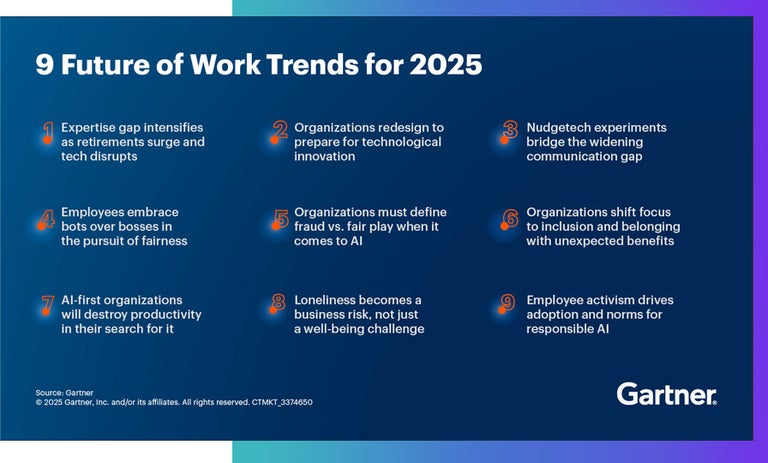
We all know that building an online persona is key to career success, but HOW you do it matters. If you’re paying attention - this is a MASSIVE opportunity.
While other candidates work feverishly to inflate, distort, smooth the edges, and otherwise polish themselves into AI avatars – you’re going to double down on the real currency in tech: authenticity.
Recent studies have shown that employers score authenticity and honesty in the top 5 most important traits they look for in top job candidates.
It’s about to be trait #1.
In this article, I’m unpacking what job catfishing is, why AI misuse is the real villain, how skill testing combats job fakery, and I’ll give you the five golden rules to follow to build trust, not phony-baloney personas with AI.
What is Job Catfishing? (+Why It’s on The Rise)
Job catfishing is when a candidate uses AI to present a deceptively inflated version of themselves online to secure job interviews, opportunities and offers.
Like the original term popularized on dating apps, to catfish someone is to use a fake online persona to hook and lure someone into a relationship.
This is the professional version of that, and it has more grey area than you think.

Not to be confused with career catfishing (Gen Z’s not pitching for work after being hired), or corporate catfishing, when your job environment or culture ends up being the catfish and isn’t what they said it was.
The big difference here is that people in tech (and soon everywhere) are doing it. And sometimes you’re not even fully aware of the negative repercussions it brings.
1: Job Competition is Extreme
Any advantage is good in this climate, right?
- It takes the average person 8 MONTHS to find a new job
- You have to send around 200 applications to find one!
- 30% of the global workforce is seeking work at any given time
- Top performers NEVER stop looking for work
It’s not being too dramatic to say that job seekers these days have the odds stacked against them. Everyone is competing for the best jobs and people want to look their best online to lock down these roles. AI is a quick fix.
2: AI-dealizing Yourself is SO Easy
High performers feel pushed to DO MORE with AI because of pressures to innovate, adopt and pioneer the future of tech.
So why not use it to make themselves appear better online?
Over the last few years AI tools have made it free and easy to perform tasks that once required serious individual attention, thought and investment.
Job catfishing is on the rise because people are willingly replacing themselves with ‘AI-dealized’ versions of themselves.
The authenticity of self is drifting, and with it – your employer’s ability to identify true top performers. If everyone looks great, and says smart things all the time – how do you tell who is real and who is faking it?

3: Hiring Bias Rewards Perfection
Recruiters often scan for perfect-fit profiles.
If you happen to have one, you’re already ahead. Because our broken recruiting system – where people are reviewing thousands of resumes a month – rewards superficial profiles.
No wonder over half of all new hires don’t work out!
Passing early screening by having an incredible online profile has never been this easy. And while it’s true that it still takes effort, the barrier to entry has never been lower.
Like, on the floor low. Sub-terranean low.
The Big Problem with AI-dealization
When you use AI tools to create an overly idealized version of yourself, your online persona stops reflecting who you really are. This is what causes authenticity drift.
AI stops being a tool for amplifying your strengths and becomes a shortcut for faking an ideal. The term ‘fake it til you make it,’ springs to mind.
Here’s why you want to avoid it:
- Employers will become hypersensitive to a sea of fake candidates and will avoid profiles that feel too artificial or overly AI-polished.
- Deepfake scams are increasing (56% of Americans are fooled by them), AI-generated fraud and theft are a real concern, so hyperawareness of cyberthreats is rising.
- Hair-trigger rejections from hiring teams looking for authenticity as a top trait among top performers will only become more widespread.
- AI is no longer novel, it creates overblown sameness not originality - and soon what your AI says, others will be saying in droves. You’ve seen it already.
Why AI Isn't the Problem - You Are (If You Misuse It)
I’ve said it before – AI isn’t the problem.
We’re all adjusting to a new way of working that requires us to think critically about the HOW and entrench our decisions in logic that will protect our interests in the future.
Your online persona / profile is maybe the most important area for this. It’s important that you acknowledge your risk and adjust to keep it low.
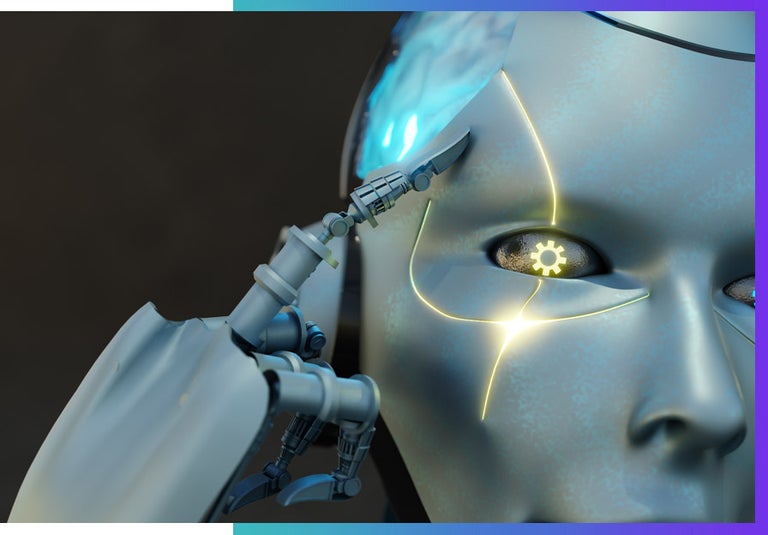
It’s not just fake news and information we have to watch out for – it’s fake people.
- 71% of images on social media are AI-generated or AI-edited
- Half of all LinkedIn posts are now AI-generated
- 45% of job seekers use AI to create their resumes
Statistically speaking the majority of your online presence is now being heavily influenced by AI. Even thought leadership is FAR less likely to be original and authentic.
As a top candidate you need to audit your current AI use, and understand where you have sacrificed authenticity and value, at the altar of speed and efficiency.
Doing the wrong thing faster, will get you nowhere quick.
The goal when building an online persona or brand is to approach it with AI as your co-pilot and agent – but to never relinquish or defer to standardized ideas, options or inputs.
Here’s a comparison chart to help you:
Overusing AI (AI-dealization) / Top Candidate (Authenticity + AI Mastery)
- Uses AI to rewrite everything: resume, cover letter, bios, posts - until none of it sounds human.
- Uses AI to polish their own words but keeps their authentic voice and tone intact.
- Generates AI headshots or filters that erase age, features, or personality.
- Uses real, professionally AI-edited headshots that show them confidently and accurately.
- Relies on AI to fabricate or inflate achievements that sound impressive but aren’t true.
- Uses AI to organize and present real achievements in the clearest, strongest way.
- Automates all social posts and comments without adding personal insight or perspective.
- Uses AI to draft post ideas but adds their own stories, humor, and expertise.
- Submits AI-written skills tests or assessments hoping to “hack” the system.
- Uses AI to prep and practice, but submits their own honest, best work.
- Lets AI craft a generic personal brand loaded with buzzwords and jargon.
- Uses AI to refine a brand message that reflects their real passions and strengths.
- Uses AI scripts in interviews or videos, sounding robotic or over-rehearsed.
- Prepares with AI but shows up live as themselves, confident and adaptive.
- Focuses on looking perfect on paper at all costs.
- Focuses on aligning strengths + fit and showing genuine interest in the role.
How Skill Testing Is the Ultimate Job Catfish Filter
At Crossover we believe that skill testing is the ultimate job catfish filter.
If your online persona is making promises your skills can’t back up – you’re job catfishing. Being able to separate the top performers from the top pretenders is key.
Instead of wading through deepfakes, embellished resumes and AI-dealized online profiles, we ask our candidates to show, not tell.
Because in the age of AI – smart communication allows average to slip in.
We asked our LinkedIn community which weakness AI fixed for them, and in a poll of 3452 people, 58% said writing/communication!
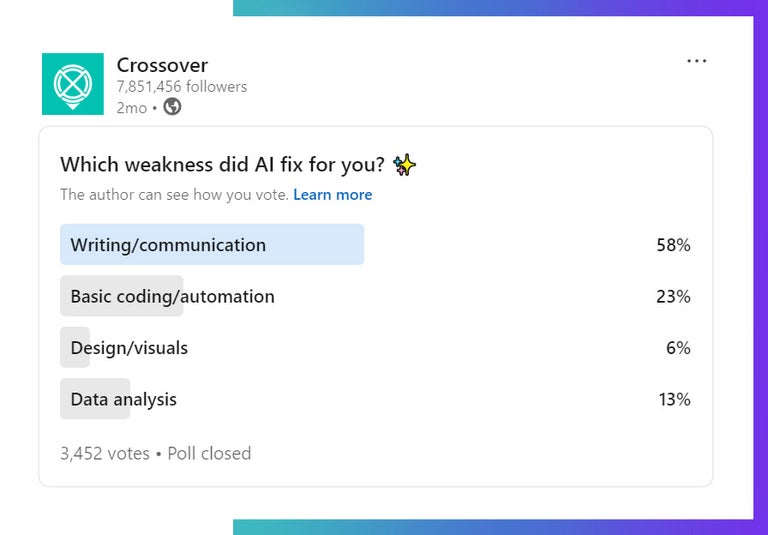
Our structured skill assessments focus on real-world ability - not how perfect your LinkedIn profile or AI-polished resume looks.
Every candidate goes through a multi-stage selection process designed to surface the REAL top 1% of talent.
- The Basic Fit Test checks if you pass our minimum requirements for the job!
- The Criteria Cognitive Aptitude Test (CCAT) measures your problem-solving speed and learning agility.
- The English Proficiency Test ensures you can communicate effectively with global teams.
- Our Real Work Assessments simulate the exact tasks of the job - whether it’s coding, writing, managing, or analyzing - with blind grading to remove bias.
- And before you’re officially hired, you’ll repeat the CCAT in a proctored test to prove your score under strict conditions.
This system filters out inflated claims, AI-fabricated personas, and resume exaggerations. It sidesteps hiring bias and zeroes in on the person BEHIND the persona.
You can’t job catfish your way into a Crossover role - only real skills, real talent, and real performance make the cut.
5 Rules for AI Use That Build Trust (Not Fake Personas)
There are 5 golden rules I stick to whenever I’m intent on using a new AI tool to enhance my online profile or content. These will keep you from drifting into AI-dealization so that you can stay authentically human.
Here’s how to brand yourself in a way that gets you hired and holds up under pressure.
Rule 1: Skill Stacking Over Story Stacking
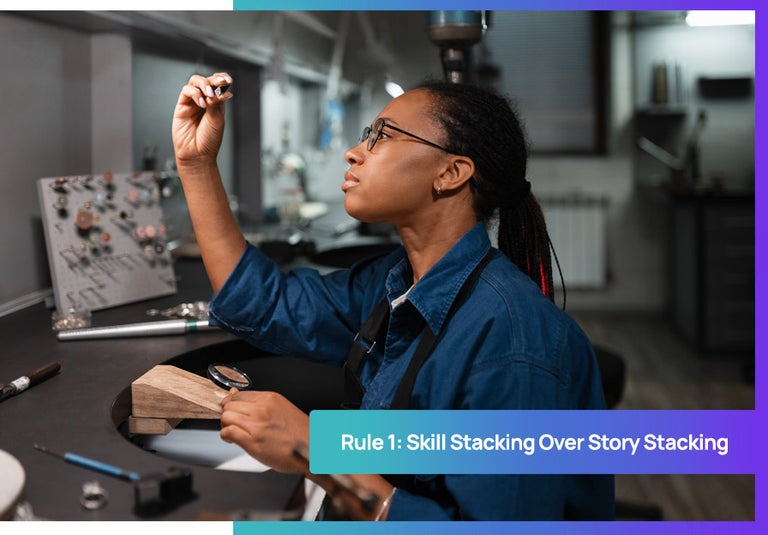
AI loves to make things seem plausible.
But before you add those ‘adjacent’ skills to your LinkedIn profile, stop and ask – can I actually do this? It’s remarkable how many liberties ChatGPT, Claude and Gemini will take when creating your story.
This can tip into more and more stories, instead of more and more actual skills.
AI should be used to learn faster, practise smarter and it should help you deepen your existing expertise. Not PAD it. Not over elaborate on it.
Never allow AI to present your skillsets as MORE than what they are. Gain the skill first, then tell that story.
Top employers are looking for performance, not performers.
Rule 2: AI as an Enhancer Not a Transplant
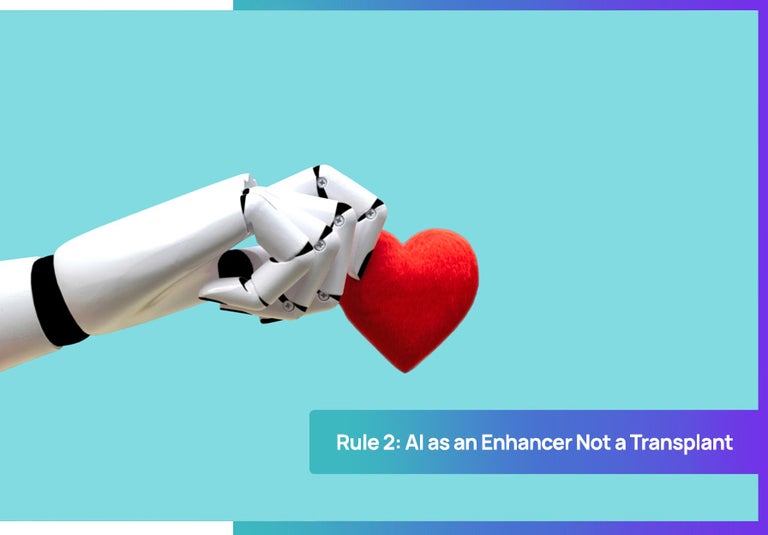
Your voice is yours and AI doesn’t sound like you.
If you’re slapping in a lazy prompt and copy and pasting the generic output into your personal bio or copy or post – you’re transplanting yourself with something average.
Write your own copy first. Use AI to refine it. Be careful not to replace your own voice with a tone that might SEEM better but doesn’t fit with who you really are.
A good practice is: if it looks obviously AI, you’ve done it wrong. It should look human. It should be invisibly AI to experts and recruiters.
- Take a real photo of yourself for LinkedIn (AI edits over AI-generated)
- STOP deferring to AI’s structures, they’re boring.
- Edit out the obvious signifiers people know are part of AI communication
With so much fakery online the last thing you want to do is come across as generic or fake. At best, it’s inauthentic – at worst, it’s suspicious.
Your quality bar starts with your online profile. If that’s not in your voice, you’ve already created a false impression of yourself an employer will discover later on.
Rule 3: Build Your Brand from Proof Not Promises

Everyone is saying and doing the same things…where are your receipts?
Now more than ever you need evidence of your expertise. Back up those claims, because every Joe Shmoe is making them now. It’s nice to be aspirational and motivated but that means nothing in reality.
It reminds me of a Kitchen Nightmare’s episode with Gordon Ramsey, where he had his tarot cards read in a restaurant. He asked the reader where she studied tarot, and she responded, “Oh I didn’t, I just started doing it.”
Anyone can say they’re great and look great now. Avoid the glittery promises!
Use AI to surface authentic wins, to visualize real results and showcase your impact. In my opinion, hype without history is just another form of catfishing.
Rule 4: Practice What You Post (Seriously!)
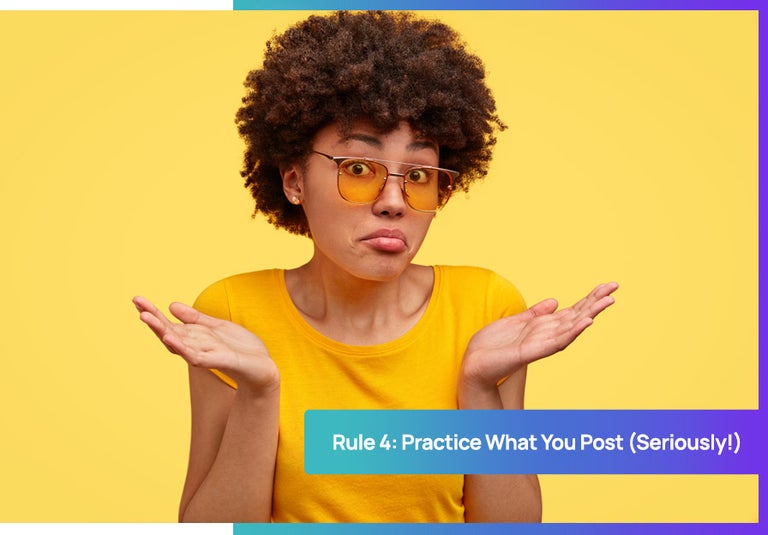
Automation isn’t greatness, integrity is greatness.
If you’re publicly declaring that you’re an expert in AI for example, you better know more than the average person – and whatever the average person can ASK any old LLM.
I’ve seen so many LinkedIn posts designed to pull on heartstrings or ragebait people into commenting, because that’s how the automation has been prompted.
Does it mean the personality behind the automation feels that way? Nope.
If you’re going to stand for something in a post or in your general profile – at least believe in it. Have an authentic opinion formed by actual research or thoughts. Not by a Google Search for what’s trending in your industry. Or a strategy for clicks.
Use AI to help articulate your actual opinion publicly – not masquerade as someone who cares, knows, or believes more than you actually do.
Rule 5: Always Audit for Authenticity

Does this look like me? Sound like me? Feel like me?
Top companies don’t hire perfect, ready-made people with nothing left to learn.
They hire people who know who they are, own what they’re great at, and stay honest about where they still have work to do.
Before you hit publish on that post, profile, or portfolio, always ask yourself, “Does this reflect the real me - or just the AI-enhanced version I want people to see?”
In the end, authenticity is what sets you apart and no amount of AI polish can fake that.
Use AI to summarize, reflect, explore or check for consistency across messaging. So that you’re proud of your online persona, because it’s just you.
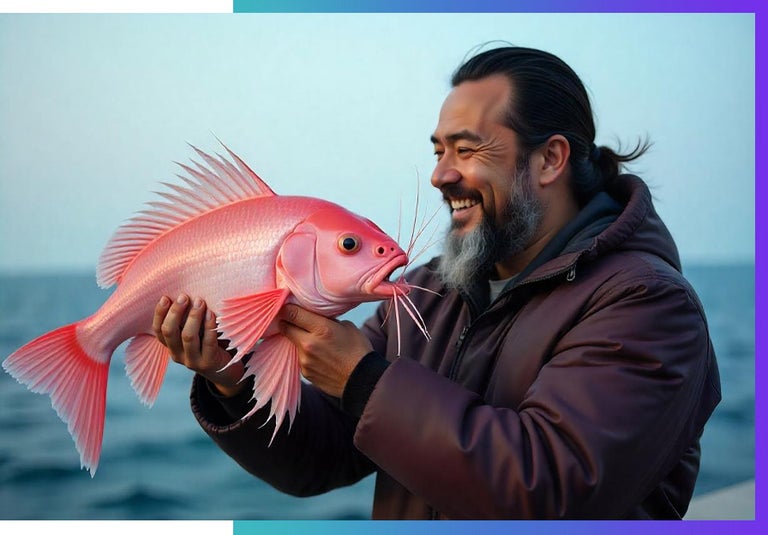
Building an Authentic Personal Brand With AI
AI is a jaw-dropping wonder-tool for top candidates, no argument there.
It can help you hook amazing interviews, net massive offers, and elevate your brand in ways we’ve never seen before.
But at this point AI isn’t a new toy, and we should be using it better.
If you allow it to pull you too far into AI-dealization - where your online persona becomes a more impressive version of yourself that doesn’t fully match your real skills - you risk damaging something far more valuable than a single job opportunity.
Your entire reputation as a true top performer hangs in the balance!
It’s tempting to let automation handle your story, to present aspirational claims you don’t fully believe in, or to post content that feels more like trend-chasing than truth-telling.
But when your skills, your voice, and your public narrative aren’t really yours, you’re entering the dangerous territory of authenticity drift.
That’s where even the smartest, most promising candidates can slip from top performer to top pretender - without realizing it. It happens slowly. Progressively.
The best candidates use AI not to create a persona, but to amplify their real expertise, real voice, and real passion.
They align what they say with what they can do, they show up as themselves, and they regularly audit to make sure their online brand reflects their genuine strengths and beliefs.
That’s AI-ntegrity (I’ll stop now).
It’s the formula for long-term trust, credibility, and success - and it’s what will keep you winning, when everyone else is parroting the same over-dramatized junk.
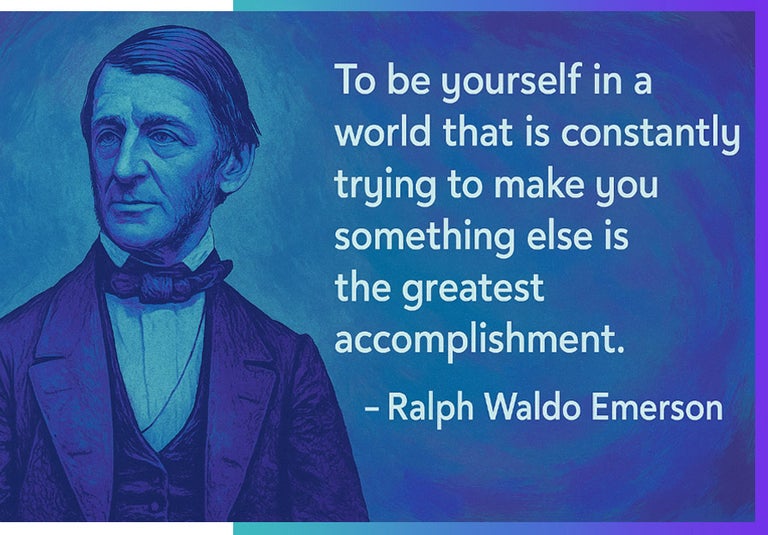
Ralph Waldo Emerson once said, “To be yourself in a world that is constantly trying to make you something else is the greatest accomplishment.”
Don’t forget that you got ahead by being yourself, first.








